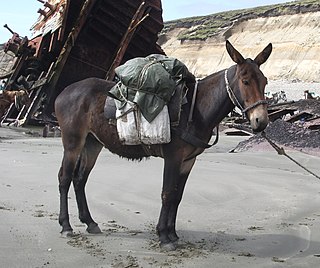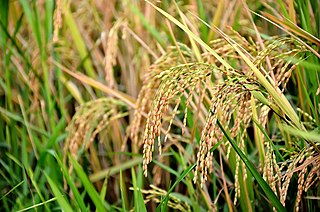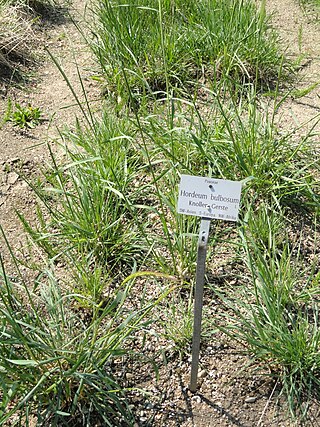Related Research Articles

Mendelian inheritance is a type of biological inheritance following the principles originally proposed by Gregor Mendel in 1865 and 1866, re-discovered in 1900 by Hugo de Vries and Carl Correns, and later popularized by William Bateson. These principles were initially controversial. When Mendel's theories were integrated with the Boveri–Sutton chromosome theory of inheritance by Thomas Hunt Morgan in 1915, they became the core of classical genetics. Ronald Fisher combined these ideas with the theory of natural selection in his 1930 book The Genetical Theory of Natural Selection, putting evolution onto a mathematical footing and forming the basis for population genetics within the modern evolutionary synthesis.

In biology, a hybrid is the offspring resulting from combining the qualities of two organisms of different varieties, species or genera through sexual reproduction. Generally, it means that each cell has genetic material from two different organisms, whereas an individual where some cells are derived from a different organism is called a chimera. Hybrids are not always intermediates between their parents, but can show hybrid vigor, sometimes growing larger or taller than either parent. The concept of a hybrid is interpreted differently in animal and plant breeding, where there is interest in the individual parentage. In genetics, attention is focused on the numbers of chromosomes. In taxonomy, a key question is how closely related the parent species are.

Triticale is a hybrid of wheat (Triticum) and rye (Secale) first bred in laboratories during the late 19th century in Scotland and Germany. Commercially available triticale is almost always a second-generation hybrid, i.e., a cross between two kinds of primary (first-cross) triticales. As a rule, triticale combines the yield potential and grain quality of wheat with the disease and environmental tolerance of rye. Only recently has it been developed into a commercially viable crop. Depending on the cultivar, triticale can more or less resemble either of its parents. It is grown mostly for forage or fodder, although some triticale-based foods can be purchased at health food stores and can be found in some breakfast cereals.
Genetic linkage is the tendency of DNA sequences that are close together on a chromosome to be inherited together during the meiosis phase of sexual reproduction. Two genetic markers that are physically near to each other are unlikely to be separated onto different chromatids during chromosomal crossover, and are therefore said to be more linked than markers that are far apart. In other words, the nearer two genes are on a chromosome, the lower the chance of recombination between them, and the more likely they are to be inherited together. Markers on different chromosomes are perfectly unlinked, although the penetrance of potentially deleterious alleles may be influenced by the presence of other alleles, and these other alleles may be located on other chromosomes than that on which a particular potentially deleterious allele is located.
A quantitative trait locus (QTL) is a locus that correlates with variation of a quantitative trait in the phenotype of a population of organisms. QTLs are mapped by identifying which molecular markers correlate with an observed trait. This is often an early step in identifying the actual genes that cause the trait variation.
Backcrossing is a crossing of a hybrid with one of its parents or an individual genetically similar to its parent, to achieve offspring with a genetic identity closer to that of the parent. It is used in horticulture, animal breeding, and production of gene knockout organisms.

Oryza sativa, also known as rice, is the plant species most commonly referred to in English as rice. It is the type of farmed rice whose cultivars are most common globally, and was first domesticated in the Yangtze River basin in China 13,500 to 8,200 years ago.

In genetics, a locus is a specific, fixed position on a chromosome where a particular gene or genetic marker is located. Each chromosome carries many genes, with each gene occupying a different position or locus; in humans, the total number of protein-coding genes in a complete haploid set of 23 chromosomes is estimated at 19,000–20,000.
Plant breeders use different methods depending on the mode of reproduction of crops, which include:
A molecular marker is a molecule, sampled from some source, that gives information about its source. For example, DNA is a molecular marker that gives information about the organism from which it was taken. For another example, some proteins can be molecular markers of Alzheimer's disease in a person from which they are taken. Molecular markers may be non-biological. Non-biological markers are often used in environmental studies.
Marker assisted selection or marker aided selection (MAS) is an indirect selection process where a trait of interest is selected based on a marker linked to a trait of interest, rather than on the trait itself. This process has been extensively researched and proposed for plant- and animal- breeding.
In genetics, association mapping, also known as "linkage disequilibrium mapping", is a method of mapping quantitative trait loci (QTLs) that takes advantage of historic linkage disequilibrium to link phenotypes to genotypes, uncovering genetic associations.
Nested association mapping (NAM) is a technique designed by the labs of Edward Buckler, James Holland, and Michael McMullen for identifying and dissecting the genetic architecture of complex traits in corn. It is important to note that nested association mapping is a specific technique that cannot be performed outside of a specifically designed population such as the Maize NAM population, the details of which are described below.
In statistical genetics, inclusive composite interval mapping (ICIM) has been proposed as an approach to QTL mapping for populations derived from bi-parental crosses. QTL mapping is based on genetic linkage map and phenotypic data to attempt to locate individual genetic factors on chromosomes and to estimate their genetic effects.

Plant breeding is the science of changing the traits of plants in order to produce desired characteristics. It has been used to improve the quality of nutrition in products for humans and animals. The goals of plant breeding are to produce crop varieties that boast unique and superior traits for a variety of applications. The most frequently addressed agricultural traits are those related to biotic and abiotic stress tolerance, grain or biomass yield, end-use quality characteristics such as taste or the concentrations of specific biological molecules and ease of processing.
Quantitative trait loci mapping or QTL mapping is the process of identifying genomic regions that potentially contain genes responsible for important economic, health or environmental characters. Mapping QTLs is an important activity that plant breeders and geneticists routinely use to associate potential causal genes with phenotypes of interest. Family-based QTL mapping is a variant of QTL mapping where multiple-families are used.
Molecular breeding is the application of molecular biology tools, often in plant breeding and animal breeding. In the broad sense, molecular breeding can be defined as the use of genetic manipulation performed at the level of DNA to improve traits of interest in plants and animals, and it may also include genetic engineering or gene manipulation, molecular marker-assisted selection, and genomic selection. More often, however, molecular breeding implies molecular marker-assisted breeding (MAB) and is defined as the application of molecular biotechnologies, specifically molecular markers, in combination with linkage maps and genomics, to alter and improve plant or animal traits on the basis of genotypic assays.
Plant breeding is process of development of new cultivars. Plant breeding involves development of varieties for different environmental conditions – some of them are not favorable. Among them, heat stress is one of such factor that reduces the production and quality significantly. So breeding against heat is a very important criterion for breeding for current as well as future environments produced by global climate change.
This glossary of genetics and evolutionary biology is a list of definitions of terms and concepts used in the study of genetics and evolutionary biology, as well as sub-disciplines and related fields, with an emphasis on classical genetics, quantitative genetics, population biology, phylogenetics, speciation, and systematics. Overlapping and related terms can be found in Glossary of cellular and molecular biology, Glossary of ecology, and Glossary of biology.

Hordeum bulbosum, bulbous barley, is a species of barley native to southern Europe, northern Africa, the Middle East and as far east as Afghanistan, with a few naturalized populations in North America, South America and Australia. Since 1970 it has been used in the Hordeum bulbosum Method to produce doubled haploid (DH) wheat and barley plants by crossing it with T. aestivum or H. vulgare, followed by the elimination of the H. bulbosum chromosomes from the offspring. These DH plants are important in breeding new varieties of wheat and barley, and in scientific studies. H. bulbosum is also being looked at as a source of genes for disease resistance and other traits for barley crop improvement.
References
- ↑ Jain, S. Mohan, S. K. Sopory, and R. E. Veilleux. 1996. In vitro haploid production in higher plants. Dordrecht: Kluwer Academic Publishers. p.317.
- 1 2 3 4 Maluszynski et al., 2003.
- ↑ B. Barnabás; B. Obert; G. Kovács (1999). "Colchicine, an efficient genome-doubling agent for maize (Zea mays L.) microspores cultured in anthero". Plant Cell Reports. 18 (10): 858–862. doi:10.1007/s002990050674. S2CID 5397111.
- ↑ Winzeler et al., 1987.
- ↑ Forster and Thomas, 2003
- 1 2 Thomas et al., 2003.
- ↑ Ardiel et al., 2002; William et al., 2002; Yi et al., 1998.
- ↑ Thomas et al., 1984.
- ↑ Schon et al., 1990.
- ↑ RCSLs, Paterson et al., 1990.
- ↑ STAIRS, Kearsey 2002.
- ↑ Thomas et al., 2000.
- ↑ Wang et al., 2001.
- ↑ International Symposium on Genetic Manipulation in Crops. 1988. Genetic manipulation in crops proceedings of the International Symposium on Genetic Manipulation in Crops, the 3rd International Symposium on Haploidy, the 1st International Symposium on Somatic Cell Genetics in Crops, Beijing, October 1984. Natural resources and the environment series, v. 22. (London: Published for the International Rice Research Institute and Academia Sinica by Cassell Tycooly), p.318.
- ↑ Immonen and Anttila, 1996.
- ↑ Friedt et al., 1986; Winzeler et al., 1987.
- Ardiel, G.S., Grewal, T.S., Deberdt, P., Rossnagel, B.G., and Scoles, G.J. 2002. Inheritance of resistance to covered smut in barley and development of tightly linked SCAR marker. Theoretical and applied genetics 104:457-464.
- Blakelsee, A.F., Belling, J., Farhnam, M.E., and Bergner, A.D.1922. A haploid mutant in the Jimson weed, Datura stramonium. Science 55:646-647.
- Burk, L.G., Gerstel, D.U., and Wernsman, E.A. 1979. Maternal haploids of Nicotiana tabacum L. from seed. Science 206:585.
- Chen, F.Q., D.Prehn, P.M. Hayes, D.Mulrooney, A. Corey, and H.Vivar. 1994. Mapping genes for resistance to barley stripe rust (Puccinia striiformis f. sp. hordei). Theoretical and Applied Genetics. 88:215-219.
- Friedt, W., Breun, J., Zuchner, S., and Foroughi-Wehr, B. 1986. Comparative value of androgenetic doubled haploid and conventionally selected spring barley line. Plant Breeding 97:56-63.
- Guha, S., and Maheswari, S. C. 1964. In vitro production of embryos from anthers of Datura. Nature 204:497.
- Immonen, S., and H. Anttila. 1996. Success in rye anther culture. Vortr. Pflanzenzuchtg. 35:237-244.
- Kasha, K. J., and Kao, K. N. 1970. High frequency haploid production in barley (Hordeum vulgare L.). Nature 225: 874-876.
- Kearsey, M. J. 2002. QTL analysis: Problems and (possible) solutions. p. 45-58. In: M.S. Kang (ed.), Quantitative genetics, genomics and plant breeding. CABI Publ., CAB International.
- Maluszynski, M.., Kasha K. J., Forster, B.P., and Szarejko, I. 2003. Doubled haploid production in crop plants: A manual. Kluwer Academic Publ., Dordrecht, Boston, London.
- Paterson, A.H., Deverna, J.W., Lanin, B., and Tanksley, S. 1990. Fine mapping of quantitative trait loci using selected overlapping recombinant chromosomes in an interspecies cross of tomato. Genetics 124:735-741.
- Schon, C., M. Sanchez,T. Blake, and P.M. Hayes. 1990. Segregation of Mendelian markers in doubled haploid and F2 progeny of barley cross. Hereditas 113:69-72.
- Thomas, W. T. B., B. Gertson and B.P. Forster. 2003. Doubled haploids in breeding p. 337-350. in :M. Maluszynski, K.J. Kasha, B.P. Forster and I. Szarejko (eds)., Doubled haploid production in crop plants:A Manual. Kluwer Academic Publ., Dordrecht, Boston, London.
- Thomas, W.T.B., Newton, A.C., Wilson, A., Booth, A., Macaulay, M., and Keith, R. 2000. Development of recombinant chromosome substitution lines: A barley resource. SCRI Annual Report 1999/2000, 99-100.
- Thomas, W.T.B., Powell, W., and Wood, W. 1984. The chromosomal location of the dwarfing gene present in the spring barley variety Golden Promise. Heredity 53:177-183.
- Wang, Z., G. Taramino, D.Yang, G. Liu, S.V. Tingey, G.H. Miao, and G.L. Wang. 2001. Rice ESTs with disease-resistance gene or defense-response gene-like sequences mapped to regions containing major resistance genes or QTLs. Molecular Genetics and Genomics. 265:303-310.
- William, K.J., Taylor, S.P., Bogacki, P., Pallotta, M., Bariana, H.S., and Wallwork, H. 2002. Mapping of the root lesion nematode (Pratylenchus neglectus) resistance gene Rlnn 1 in wheat. Theoretical and applied genetics 104:874-879.
- Winzeler, H., Schmid, J., and Fried, P.M. 1987. Field performance of androgenetic doubled haploid spring wheat line in comparison with line selected by the pedigree system. Plant breeding 99:41-48.
- Yi, H.Y., Rufty, R.C., Wernsman, E.A., and Conkling, M.C. 1998. Mapping the root-knot nematode resistance gene (Rk) in tobacco with RAPD markers. Plant Disease 82:1319-1322.